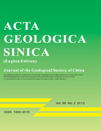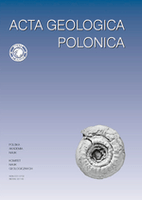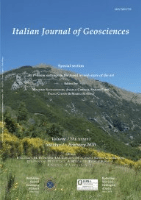
Spisanie Na B Lgarskoto Geologichesko Druzhestov-Review of the Bulgarian Geological Society
Scope & Guideline
Bridging theory and practice in Earth sciences.
Introduction
Aims and Scopes
- Geological Research and Exploration:
The journal publishes studies on various geological formations, mineral deposits, and paleogeographic reconstructions, emphasizing the geological history and resources of Bulgaria. - Environmental Geology and Geohazards:
Research addressing environmental impacts of geological processes, including pollution assessments, landslide studies, and climate change effects on geological stability. - Applied Geosciences and Engineering Geology:
Papers explore practical applications of geology in engineering, including site assessments for construction, hydrogeological modeling, and resource management. - Geochemistry and Mineralogy:
Focus on the chemical composition and properties of geological materials, including studies on mineral associations, geochemical processes, and the implications for resource extraction. - Paleontology and Paleoenvironmental Studies:
The journal includes research on fossil records and paleoenvironmental conditions, contributing to the understanding of historical climate changes and biological evolution. - Geological Education and Public Engagement:
The journal promotes educational initiatives and public awareness of geology, featuring articles on geological excursions, conferences, and notable figures in Bulgarian geology.
Trending and Emerging
- Geochemical Analysis and Environmental Monitoring:
There is a growing emphasis on geochemical studies, particularly in relation to environmental monitoring, pollution assessment, and the impacts of climate change on geological resources. - Geoinformation Technologies and 3D Modeling:
The use of geoinformation technologies, including GIS and 3D geological modeling, has become increasingly prevalent, facilitating advanced analyses and visualizations of geological data. - Sustainable Resource Management:
Emerging research focuses on sustainable practices in resource extraction and management, aligning with global trends towards environmental sustainability and responsible mining. - Hydrogeology and Water Resource Studies:
Research related to hydrogeological conditions, groundwater management, and the impacts of human activities on water resources has gained prominence, reflecting increased concerns over water scarcity and quality. - Interdisciplinary Approaches in Geosciences:
There is a noticeable trend towards interdisciplinary research, integrating geology with fields such as archaeology, environmental science, and engineering to address complex geological challenges.
Declining or Waning
- Traditional Geological Mapping:
There has been a noticeable decrease in publications solely focused on traditional geological mapping techniques, as the field shifts towards more integrated and technology-driven approaches. - Petrology of Common Rock Types:
Research on common rock types and basic petrology has seen a decline, possibly as the field moves towards more specialized studies involving complex mineral deposits and advanced analytical techniques. - Geological History of Lesser-Known Regions:
Papers focusing on the geological history of less prominent regions within Bulgaria have become less frequent, indicating a potential shift towards more significant or economically relevant areas. - Historical Geological Studies:
While historical perspectives are still valuable, there is a waning interest in studies primarily focused on historical geological events without direct application to current geological challenges. - Non-Technical Aspects of Geology:
There seems to be a decrease in articles that discuss geological concepts in a non-technical manner aimed at broader audiences, as the journal increasingly targets a specialized readership.
Similar Journals

ACTA GEOLOGICA SINICA-ENGLISH EDITION
Innovating Geological Research for a Sustainable FutureACTA GEOLOGICA SINICA-ENGLISH EDITION is a distinguished academic journal published by Wiley, providing a platform for cutting-edge research in the field of geology. With an ISSN of 1000-9515 and E-ISSN 1755-6724, this journal has been a pivotal resource since its inception in 1988, catering to scholars and professionals until 2024. The journal is recognized for its high-quality articles, achieving a Q2 ranking in the field of Geology according to the 2023 category quartiles, and ranks #122 out of 321 in the Scopus Earth and Planetary Sciences sector, placing it within the 62nd percentile among its peers. Although currently not available as an open access publication, it remains a significant repository of knowledge that supports ongoing geological research and exploration. For researchers, students, and professionals looking to deepen their understanding of geological sciences, ACTA GEOLOGICA SINICA-ENGLISH EDITION stands as an essential journal, promoting collaboration and innovation in the earth sciences.

GEOLOGICA BELGICA
Shaping the Future of Earth Science ScholarshipGEOLOGICA BELGICA is a distinguished open access journal dedicated to advancing the field of Earth and Planetary Sciences, published by Geologica Belgica Luxemburga Scientia & Professionis. With an ISSN of 1374-8505 and E-ISSN of 2034-1954, the journal has been a beacon of knowledge since its establishment in 1998, ensuring the broad accessibility of crucial research findings. Based in Brussels, Belgium, the journal is recognized for its impactful contributions and has achieved a commendable Q2 ranking in the Earth and Planetary Sciences category for 2023. This makes it a vital resource for researchers, professionals, and students alike, encouraging the dissemination of cutting-edge research. Spanning a diverse range of topics within its scope and converging from 2007 to 2024, GEOLOGICA BELGICA remains committed to fostering dialogue and collaboration among earth scientists globally, further enhancing its relevance and influence in this essential field of study.

Turkiye Jeoloji Bulteni-Geological Bulletin of Turkey
Connecting innovative geological theories with real-world applications.Turkiye Jeoloji Bulteni-Geological Bulletin of Turkey (ISSN: 1016-9164) is a prominent scholarly journal published by the TMMOB JEOLOJI MUHENDISLERI ODASI in Türkiye, dedicated to advancing the field of geology through high-quality research and dissemination of significant scientific findings. With an emphasis on geological studies pertinent to the region and its global implications, the journal serves as a crucial platform for researchers, professionals, and students aiming to share and explore innovative theories, methodologies, and case studies. Although the journal operates under a traditional access model, its rich content provides valuable insights into varied topics including but not limited to mineralogy, geophysics, petrology, and environmental geology. Furthermore, the journal's commitment to exhibiting originality and relevance ensures its vital role in shaping geological research, fostering collaboration among academics and practitioners alike.

Visnyk of Taras Shevchenko National University of Kyiv-Geology
Pioneering Research in Earth Sciences from the Heart of UkraineVisnyk of Taras Shevchenko National University of Kyiv-Geology is a premier academic journal dedicated to advancing the field of geology and related earth sciences. Published by the esteemed NATL TARAS SHEVCHENKO UNIV KYIV, this journal serves as a vital platform for researchers, professionals, and students to disseminate original research findings, innovative methodologies, and comprehensive reviews that address contemporary geological challenges. With an ISSN of 1728-2713 and an E-ISSN of 2079-9063, the journal is committed to upholding rigorous academic standards and excellence, although it currently operates without an open access model. The Visnyk primarily focuses on topics such as mineralogy, geophysics, geological engineering, and environmental geology, thus providing a broad spectrum of insights into the ever-evolving discipline of geology. Situated in Kyiv, Ukraine, it not only fosters local research but also contributes to the global geological discourse, making it an indispensable resource for anyone engaged in earth sciences.

ACTA GEOLOGICA POLONICA
Transforming geological discussions into impactful knowledge.ACTA GEOLOGICA POLONICA is a distinguished journal published by the Polska Akademia Nauk, in collaboration with the University of Warsaw's Geology Department. Since its inception, it has served as a vital platform for disseminating innovative research in the field of Geology, reflecting a commitment to advancing scientific knowledge in Earth and planetary sciences. With an ISSN of 0001-5709 and an E-ISSN of 2300-1887, this journal provides a rigorous review process and is classified in the Q3 quartile for Geology as of 2023, indicating its growing influence in the discipline. Despite not being open access, the journal facilitates meaningful contributions that span a range of geological topics from fundamental research to applied sciences, thereby enriching the academic landscape. Researchers, professionals, and students alike are encouraged to engage with the valuable findings and discussions contained within its pages, which continue to shape the future of geological inquiry.

JOURNAL OF THE GEOLOGICAL SOCIETY OF INDIA
Bridging theory and practice in the realm of geology.JOURNAL OF THE GEOLOGICAL SOCIETY OF INDIA, published by Springer India, serves as a pivotal platform for researchers and practitioners in the field of geology. Established in 1979, this journal has been instrumental in advancing geological research throughout India, showcasing both regional studies and cutting-edge global research. With its Category Quartile ranking of Q3 in the geology category for 2023, and a significant Scopus rank of 171 among 321 journals in Earth and Planetary Sciences, it remains a respected source of scholarly activity. The journal is dedicated to the dissemination of original research articles, reviews, and case studies that encapsulate the dynamic scope of geological science, thus contributing to the understanding of geological phenomena. Although currently not offering open access, the journal maintains a commitment to high-quality scholarship and aims to engage a diverse readership, enhancing the knowledge and practice of geology across various disciplines.

Journal of Geosciences
Unveiling the Secrets of Our Planet, One Study at a TimeJournal of Geosciences is a distinguished peer-reviewed journal published by CESKA GEOLOGICKA SPOLECNOST, based in the Czech Republic, that serves as a vital platform for the dissemination of innovative research in the field of Earth and Planetary Sciences. With an ISSN of 1802-6222 and E-ISSN of 1803-1943, this journal has established its significance within the academic community, evidenced by its Q3 ranking in both Earth and Planetary Sciences and Geology. The journal covers a broad array of topics, making it an essential resource for researchers, professionals, and students interested in geoscientific advancements and discoveries. The Journal of Geosciences reflects a commitment to high-quality scholarship, embracing a variety of methodologies and interdisciplinary approaches, and provides open access to its content, thereby encouraging global collaboration and knowledge sharing among geoscientists. With a publication history converging from 2007 to 2024, it continues to be a prominent venue for critical conversations and developments in the ever-evolving field of geosciences.

ANNALES SOCIETATIS GEOLOGORUM POLONIAE
Illuminating the Depths of Earth Sciences.ANNALES SOCIETATIS GEOLOGORUM POLONIAE is a distinguished journal published by the Polish Geological Society, focusing on pivotal research in the fields of geology, economic geology, and stratigraphy. With an ISSN of 0208-9068, this journal has established itself as an essential platform for disseminating significant findings and advancements in geological sciences since its convergence in 2008. The journal proudly holds a Q2 quartile ranking in the categories of Economic Geology, Geology, and Stratigraphy as of 2023, indicating its respectable position within the global academic community. Researchers will find its indexed status in Scopus, ranking #138/321 in Geology and showcasing a solid presence in key geological sub-disciplines. While the journal is not open access, it remains a vital resource for professionals and students striving for insight into contemporary geological research. Located in Krakow, Poland, the journal continues to contribute significantly to the understanding of geological processes and resources, making it an indispensable reference for anyone in the field.

STRATIGRAPHY AND GEOLOGICAL CORRELATION
Exploring the Layers of Earth’s HistorySTRATIGRAPHY AND GEOLOGICAL CORRELATION is a prominent scholarly journal published by PLEIADES PUBLISHING INC, featuring a dedicated focus on the fields of geology, stratigraphy, and paleontology. With ISSN 0869-5938 and E-ISSN 1555-6263, this journal has been disseminating significant research findings since its inception in 1994, continuously contributing to the academic discourse through 2024. Despite not currently offering open access, its relevance is underscored by its Category Quartiles for 2023, where it has established itself as Q3 in Geology and Paleontology, and Q2 in Stratigraphy. STRATIGRAPHY AND GEOLOGICAL CORRELATION ranks #29 out of 55 in Stratigraphy and #186 out of 321 in Geology according to Scopus metrics, positioning it within the competitive landscape of Earth and Planetary Sciences. Researchers, professionals, and students are invited to engage with the journal’s content to deepen their understanding and foster innovation within these critical areas of study.

Italian Journal of Geosciences
Empowering Inquiry: Your Source for Geoscientific ExcellenceItalian Journal of Geosciences, published by the Società Geologica Italiana, is a distinguished platform for the dissemination of research in the fields of Earth and Planetary Sciences and Geology. With an impressive impact factor reflected in its 2023 rankings, where it placed in the Q3 category across its related fields, this journal serves as a vital resource for academics, practitioners, and students. Established in 2010 and poised to continue until 2024, the journal showcases critical advancements and interdisciplinary studies that deepen our understanding of geological processes and Earth systems. Operating under open access options, it offers robust accessibility to a broad audience, facilitating wider dissemination of knowledge. The journal's affiliation with Università degli Studi La Sapienza in Rome, Italy, further underscores its commitment to academic excellence and innovation in geosciences.